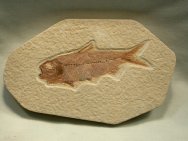|  Description:
This 50 million year-old, Eocene-Era fossil fish comes from one
of the world's famous Laggerstatten, the Green River Formation in
Wyoming. A small portion of the fish fossils from Green River exhibits
such fine preservation. The significant extent of soft-tissue preservation
that makes the site famous is evident in this specimen. Description:
This 50 million year-old, Eocene-Era fossil fish comes from one
of the world's famous Laggerstatten, the Green River Formation in
Wyoming. A small portion of the fish fossils from Green River exhibits
such fine preservation. The significant extent of soft-tissue preservation
that makes the site famous is evident in this specimen.
This
particular fish is Knightia eocaena, the State Fossil of Wyoming.
In Fossil Lake, these fish reach their maximum size of 25 cm, but
averages roughly half that. Knightia was a schooling fish which
is sometimes found in mass mortality layers confined to a single
plane, indicative of a single event. Theories as to the reasons
include stratified water turnovers as well as poisoning due to blooms
of blue-green algae. The modern-day Alewife is known to do so in
the Great Lakes of the US.
About
the Green River Formation: Class Actinopterygii, the ray-finned
bony fishes, comprise almost half of all known species of vertebrates,
some 20,000 extant species. There are numerous locations worldwide
that are noted for wondrous preservation of bony fishes, and the
Green River formation that covers some 25,000 square miles of SW
Wyoming, west Colorado and east Utah is one of the premier examples.
The formation is one of the largest lacustrine sedimentary accumulations
in the world, and spans the period from 40 to 50 million years ago
during the Eocene Epoch.
During
the Eocene, based on the fossil record, the region was sub-tropical
to temperate. Some 60 vertebrate taxa have been described from the
formation, including crocodiles, boa constrictors, and birds, as
well as abundant invertebrates and plants. The unusually excellent
preservation of the Green River fish fossils is usually attributed
to a combination of two factors: 1) a cold period during the Eocene
that would have caused dead fish to sink faster due to a less inflated
swim bladder; and 2) the great depth of the lakes and the consequent
anoxic conditions that would have often prevented scavengers from
disturbing the carcasses.
|